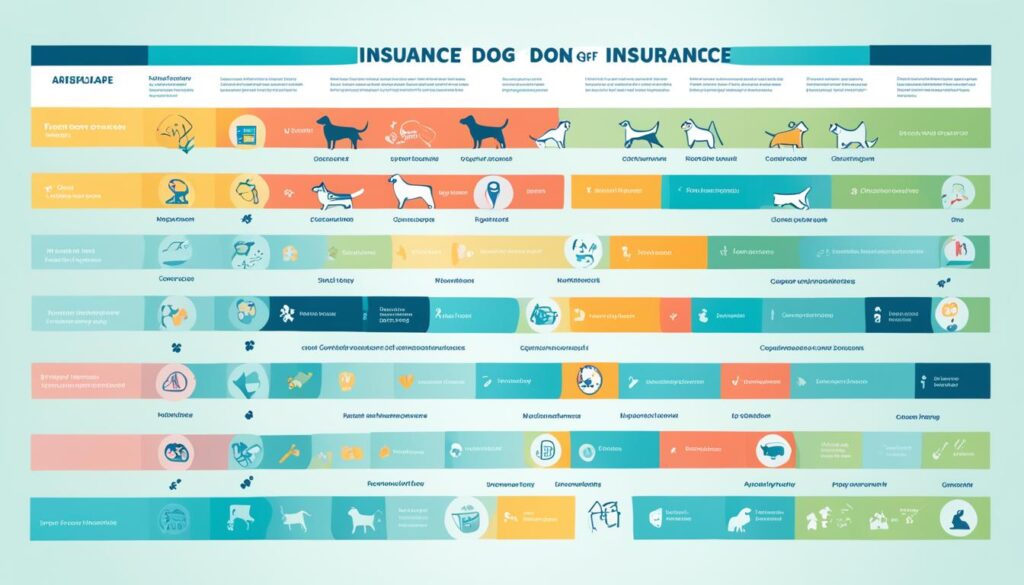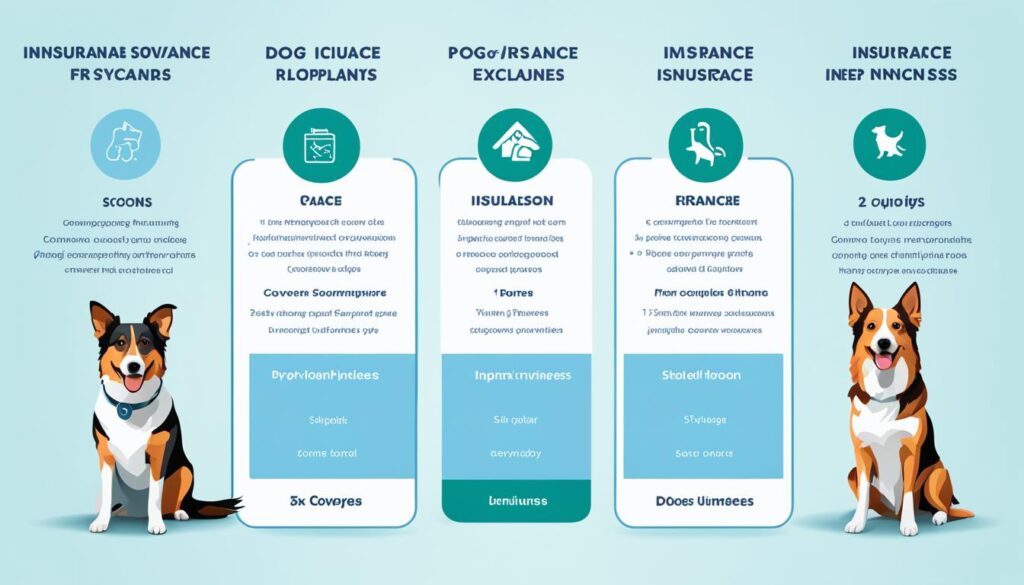Did you know the average cost of pet insurance in the UK is £271 per year, or about £22.60 per month? With more people getting dogs, picking the right insurance is key. This guide will help you understand dog insurance costs, coverage, and what to look for in a policy for your dog.
Key Takeaways
- The average cost of pet insurance in the UK is £271 per year, or £22.60 per month.
- Starting prices for dog insurance range from £274 per year to £117 per year for cats.
- Factors like breed, age, location, and coverage options can significantly impact the cost of dog insurance.
- Understanding the different policy types, such as accident-only, time-limited, and lifetime coverage, is essential when selecting the right plan.
- Exclusions and limitations in dog insurance policies should be carefully reviewed to ensure your pet’s needs are covered.
Understanding the Importance of Dog Insurance
Our dogs are now more than just pets; they are our beloved family members. They deserve the best care and protection. That’s why more people are getting pet insurance for their dogs.
Dogs as Family Members
Our dogs are now a big part of our lives. They live with us, share our love, and follow our daily routines. This closeness makes us want to protect them even more. That’s why many are getting dog insurance.
Insurance helps cover unexpected vet bills. It gives us peace of mind. Our dogs get the care they need without worrying about high costs.
Rising Popularity of Pet Insurance
- More people claim on their pet insurance every year than their house or car insurance.
- Insurance that covers accidents, illnesses, damage to property, and more is essential for dogs.
- Long-term conditions like arthritis and diabetes may require lifelong treatment for dogs.
More people now see the value in dog insurance. They understand it can help with both financial and emotional costs. So, the pet insurance market is growing, offering many options for our dogs.
“Insurance allows for monthly budgeting for veterinary bills and offers various payment options (e.g. direct debit).”
Thanks to easier access and lower costs, more pet owners are getting dog insurance. This ensures their dogs get the best care now and in the future.
What Does Dog Insurance Cover?
As a pet owner, it’s key to know what dog insurance covers. These policies can differ a lot in what they cover. So, it’s important to look at the details before choosing. Let’s look at the main coverage options in dog insurance.
Accident-Only Coverage
Accident-only coverage is one of the simplest types of dog insurance. It helps pay for unexpected injuries like broken bones or bite wounds. These plans usually cost less but might not cover illnesses or other health issues.
Illness Coverage
More complete dog insurance plans cover illnesses. They help with a wide range of health problems, from infections to cancer. This coverage is great for managing the costs of tests, treatments, and ongoing care for your dog.
Additional Coverage Options
- Wellness Care: Some insurance plans offer wellness coverage. This includes routine vet visits, shots, and preventive care. It helps keep your dog healthy and happy.
- Alternative Therapies: More insurers are adding coverage for things like acupuncture and hydrotherapy. These options can help with certain health issues in dogs.
Knowing about these coverage types helps pet owners pick the right insurance plan for their dogs.

| Coverage Type | Description | Typical Limits |
|---|---|---|
| Accident-Only | Covers unexpected injuries, such as broken bones, bite wounds, or accidental poisoning. | $2,000 – $5,000 per incident |
| Illness | Provides protection against a wide range of medical conditions, from infections and chronic diseases to cancer and other serious health issues. | $3,000 – $10,000 per year |
| Wellness Care | Covers routine veterinary check-ups, vaccinations, and preventive treatments. | $250 – $500 per year |
| Alternative Therapies | Includes coverage for acupuncture, hydrotherapy, and physical therapy. | $500 – $2,000 per year |
Remember, each insurance provider offers different coverage and limits. It’s important to check the policy details to find the best plan for your dog and your budget.
Exclusions and Limitations
Pet insurance has exclusions and limitations you should know about. Knowing these can help you pick a plan that fits your dog’s needs. It also helps avoid surprises later.
Pre-existing conditions are a common exclusion. This means health issues your dog had before the policy started won’t be covered. Congenital or hereditary disorders, which your dog was born with, are often not covered by standard policies.
Some pet insurance plans don’t cover breed-specific conditions. Certain dog breeds have health problems that insurers might not cover. For example, hip dysplasia is a big concern for big breeds like Labradors and German Shepherds.
Cosmetic or elective procedures, like teeth cleaning or ear cropping, aren’t covered by pet insurance. Routine care, including vaccinations and flea prevention, is often not covered. Also, costs related to breeding or pregnancy are usually not part of dog insurance.
| Exclusion | Explanation |
|---|---|
| Pre-existing conditions | Any health issues your dog had before the policy started will not be covered. |
| Congenital or hereditary disorders | Conditions your dog was born with are often excluded from standard policies. |
| Breed-specific conditions | Some insurers may exclude coverage for health problems common to certain dog breeds. |
| Cosmetic or elective procedures | Teeth cleaning, ear cropping, and other non-essential treatments are typically not covered. |
| Routine care | Vaccinations, flea/tick prevention, and wellness exams are commonly excluded. |
| Breeding-related expenses | Costs associated with breeding or pregnancy are often not included in dog insurance coverage. |
When picking a pet insurance policy, it’s key to read the fine print. This way, you’ll know the limitations and exclusions. It ensures the coverage fits your dog’s needs and offers the protection you want.
Cost Factors for Dog Insurance
The cost of dog insurance depends on several things. These include your pet’s breed and age, where you live, and the coverage you pick. Knowing these factors can help you find a good and affordable dog insurance plan.
Breed and Age
Older dogs and some breeds prone to health issues might pay more for insurance. For instance, big breeds like Rottweilers could pay about $124 a month for unlimited coverage. Smaller breeds like Beagles might pay $68 a month. As dogs get older, their insurance costs go up because they face more health risks.
Location
Where you live can also affect the cost of dog insurance. Places with higher vet costs, like big cities in California, might charge more than areas with lower costs, like North Carolina.
Coverage Options
The kind of coverage you pick, like accident-only or full coverage, changes your monthly premium. Policies with more coverage, lower deductibles, and higher reimbursement percentages cost more. Options like vet fee limits and liability coverage can also affect the price.
| Coverage Type | Average Annual Cost | Average Monthly Cost |
|---|---|---|
| Accident-Only | $480 | $40 |
| Illness and Accident | $816 | $68 |
| Unlimited Annual Coverage | $816 | $68 |
Thinking about these factors can help you choose a dog insurance plan that suits your budget and your pet’s needs.

Key Terms Explained
Understanding pet insurance terms can be tough, but it’s key to picking the right plan for your pet. Let’s look at some important ideas you’ll see when looking at dog insurance options.
Annual Limit
The annual limit is the most an insurer will pay each year for your dog’s vet bills. It shows the limit of coverage you’ll get. This helps you plan your budget better.
Deductible
The deductible is what you pay first before your dog insurance kicks in. Deductibles can be from $0 to $1,000 or more. A higher deductible means lower monthly payments.
Reimbursement Percentage
The reimbursement percentage tells you how much of the vet costs you’ll get back. It usually ranges from 70% to 90%. So, you’ll pay the rest, 10% to 30%, of the bill.
Waiting Period
The waiting period is the time before your pet insurance starts covering you. It’s often 14 days for illness and up to 6 months for some conditions. This makes sure you can’t claim for pre-existing problems right away.
Knowing these pet insurance terms helps you pick the best dog insurance plan. It matches your pet’s needs and your budget.
Choosing a Veterinarian
Choosing a vet for your insured dog is easy. Most plans let you see any licensed vet. This means you can keep seeing your trusted vet, keeping a strong bond. This bond ensures your dog gets the best care.
Some insurers have preferred vets, but you can see any vet with insurance. This is key when picking a policy. It lets you keep your vet and not worry about vet bills.
It’s important to have a good relationship with your vet. They know your dog’s health history and can give advice. With insurance, you can worry less about costs. This lets you make better choices with your vet.

Choosing a vet for your insured dog means you can see any vet. This lets you keep your dog’s care with a vet you trust. You get the best treatment and use your insurance to protect your finances.
The Claims Process
Understanding the dog insurance claims process is easy once you know the steps. First, pay the vet bill upfront, then submit a claim to your insurance company. Many insurers let you submit claims online or through a mobile app, making it quick to get back your dog vet bills.
To start the dog insurance claims process, collect the needed documents like invoices and receipts. Make sure to check your policy for what’s required for a claim. You’ll see things like:
- Timeframe for submitting claims
- Necessary supporting documents
- Claim submission methods (online, mobile app, or mail)
- Information about your pet and the medical treatment received
With everything prepared, contact your insurance provider to start the claims process. Many companies make it easy with digital platforms. You can upload documents and track your claim’s progress. This way, you get your reimbursement for dog vet bills faster and reduce your out-of-pocket costs.
Knowing how the dog insurance claims process works and following your provider’s rules can help you get the most from your pet’s coverage. Stay organized and proactive to confidently go through the claims process. This way, you can focus on giving your pet the best care possible.
“Proactively managing the dog insurance claims process can help ensure you receive the maximum reimbursement for your pet’s veterinary expenses.”
Is Dog Insurance Worth It?
Deciding if dog insurance is a good buy depends on your situation and what you value as a pet owner. Many find it offers peace of mind, lets them give their pets full care, and helps avoid tough money choices.
Reasons for Purchasing Dog Insurance
Many pet owners buy dog insurance for good reasons:
- Being a responsible pet owner means getting insurance to ensure your pet gets the best care.
- It protects you from unexpected vet bills, which can be very high.
- It lets you choose care for your pet based on what they need, not just what you can afford.
Recently, about 5.7 million cats and dogs got insured in the U.S. in 2023. This is a 17.1% jump from the year before. The average monthly cost is $51, and the yearly cost is $612 for a policy with $5,000 coverage, a $250 deductible, and 80% reimbursement.
Costs and coverage vary by your pet’s breed, age, and where you live. Yet, many pet owners see the value in dog insurance. It offers peace of mind and financial security.
“Pet insurance can be a real lifesaver when unexpected vet bills arise. It’s given me the freedom to focus on my dog’s health without worrying about the financial burden.”
The choice to get dog insurance is up to you. But for many, the benefits are clear. It’s a smart move for your pet’s health and happiness.
Buying Tips for Dog Insurance
When looking for dog insurance, it’s key to balance cost, coverage, and the provider’s reputation. Make sure to check the policy details like exclusions, deductibles, and how much you’ll get back. This helps you pick a plan that fits your dog’s health needs and your budget.
Here are some tips for buying dog insurance:
- Understand the different coverage options: Look into accident-only, illness, and wellness benefits. Pick the one that fits your dog’s needs.
- Compare deductibles and reimbursement rates: Lower deductibles mean higher monthly costs but less out-of-pocket during claims. Aim for a provider with a 80% or higher reimbursement rate.
- Evaluate the provider’s reputation: Check their financial health, customer service, and reviews from other pet owners. A good reputation means easier claims filing.
- Consider breed-specific needs: Some breeds face certain health issues. Find insurance that covers your dog’s breed and age.
- Review exclusions and pre-existing conditions: Know what your policy covers and doesn’t, including pre-existing conditions. This avoids surprises when you file a claim.
By taking your time to carefully choose dog insurance and consider the factors when getting dog insurance, you can get the best coverage for your dog. This ensures they get the care they need.

“Investing in pet insurance can be a game-changer for pet owners, providing financial protection and peace of mind during unexpected health emergencies or illnesses.”
| Provider | Monthly Premium | Annual Benefit | Reimbursement Rate |
|---|---|---|---|
| Lemonade | $15.48 – $50.77 | $5,000 | 90% |
| The Swiftest Average | $26.31 – $71.74 | $5,000 – Unlimited | Not Specified |
By thinking about these tips for buying dog insurance, how to choose dog insurance, and factors to consider when getting dog insurance, you can find the best coverage for your dog. This way, you ensure they get the care they deserve.
how much is pet insurance for a dog uk
Finding out how much pet insurance costs for dogs in the UK can be tricky. It depends on many things. In 2022, the average cost was £327, up from £271 in 2019, says the Association of British Insurers (ABI).
For those wanting to insure their dogs, prices range from £10 a month for accident-only to £50 for full coverage. The cost changes based on the dog’s breed, age, where you live, and the coverage you choose.
- Accident-only pet insurance can cost under £100 a year.
- Policies covering both accidents and illnesses start around £125 a year for dogs.
- Policies with vet limits of £6,000 to £10,000 begin at £20 a month for both accidents and illnesses.
Vet bills can be high, with some treatments costing £2,000 to £8,000. This shows why comprehensive pet insurance is important. It helps cover unexpected and costly medical bills.
When looking for dog insurance, think about what you need. Look at coverage options, limits, deductibles, and how much you’ll get back. Comparing quotes from different companies can help you find a good deal for your pet.
“The average pet insurance cost for dogs is $576 per year, and for cats, it is $336 per year. This is based on a policy with $5,000 of annual coverage, a $250 deductible, and an 80% reimbursement level.”
In summary, the cost of pet insurance for dogs in the UK varies a lot. By understanding what affects the cost and comparing options, owners can find a good policy that fits their budget.
Coverage Variations Among Providers
When looking for dog insurance, it’s key to know that coverage can change a lot between providers. Most plans cover accidents and illnesses, but what they include and exclude can vary. Some offer extra benefits like alternative therapies or help for behavioral issues.
To pick the best coverage for your dog, review policy details and compare different providers. This way, you can understand the comparing dog insurance coverage and differences in pet insurance plans. It helps you make a smart choice on what to look for in dog insurance.
Comparing Coverage Options
When comparing dog insurance coverage, think about the protection level. Some plans cover many treatments, while others cover less. It’s important to know what you’re getting.
- Accident-only policies cover injuries from accidents, like broken bones or cuts.
- Illness coverage plans protect against many medical conditions, including infections and chronic diseases.
- Extra coverage options, like alternative therapies or help for behavioral issues, can make a policy better.
Knowing the differences in pet insurance plans helps you pick the right one for your dog’s needs and your budget.

Exclusions and Limitations
Be aware of what’s not covered in pet insurance policies. Some don’t cover preexisting conditions or routine care. Reading the policy closely can help you what to look for in dog insurance and know what’s covered.
“Understanding the nuances of pet insurance coverage can be the key to finding the right plan for your furry family member.”
By researching and comparing differences in pet insurance plans, you can find a policy that suits your dog’s needs and your budget.
Pre-Existing Conditions and Exclusions
When looking into dog insurance, one big thing to know is that pre-existing conditions aren’t covered. These are health issues your dog had before the policy started or during the waiting period. Most insurers won’t cover these because they already knew about them.
Also, some dog insurance plans don’t cover breed-specific health problems, cosmetic or elective surgeries, and routine care. It’s key to know these exclusions when picking a plan to make sure your dog’s health needs are met.
- Pre-existing conditions: Any health problems your dog had before the policy started or during the waiting period are usually not covered by pet insurance.
- Breed-specific health issues: Some insurance plans might not cover known health problems of certain breeds, like hip dysplasia in big dogs.
- Cosmetic or elective procedures: Things like ear cropping, tail docking, or non-essential surgeries are often not covered by pet insurance.
- Routine care: Things like yearly check-ups, shots, and teeth cleaning are usually not covered by standard pet insurance plans.
When choosing a dog insurance plan, make sure to look at the policy details and what’s not covered. This way, you can pick a plan that fits your pet’s needs and your budget. Knowing what’s not covered helps you make a smart choice and protect your furry friend well.
“Knowing what’s excluded from pet insurance coverage is just as important as understanding what’s included. This helps you avoid surprises down the line when you need to file a claim.”

Remember, the exclusions and limits of dog insurance can change a lot between providers. So, it’s important to research and compare policies to find the best one for your pet’s health needs. Being well-informed lets you make sure your furry friend gets the coverage they need, without any surprises.
Wellness Plans and Routine Care
Ensuring your furry friend’s well-being is crucial. Many dog insurance plans now offer wellness packages. These cover routine and preventive services for your pet. They include annual check-ups, vaccinations, heartworm prevention, and more.
Wellness plans are a great addition to your dog’s insurance. They help you budget for regular healthcare costs. By paying monthly, you avoid unexpected vet bills. But, make sure the plan fits your dog’s needs and your budget.
| Wellness Plan for Dogs | Monthly Cost |
|---|---|
| Small Dogs ( | £15.00 |
| Medium Dogs (10 – 20kg) | £17.00 |
| Large Dogs (20 – 40kg) | £19.00 |
| Extra Large Dogs (40 – 60kg) | £21.00 |
These plans cover many preventive services, such as:
- Annual check-ups and vaccinations
- Heartworm prevention
- Nail trimming and anal gland expression
- Discounts on additional services like dental cleanings and blood tests
Investing in a wellness plan means your dog gets the care they need. This can save you money and give you peace of mind. You’ll be ready for your pet’s routine healthcare costs.
“The Wellness Plan has been a game-changer for our family. It’s so convenient to have all of our dog’s routine care covered, and the discounts on additional services have been a huge help.”
When picking a wellness plan, think about your dog’s needs and the plan’s details. Look at different providers to find the best fit for your pet and budget. A wellness plan is a smart choice for your dog’s health and happiness.

Reputation and Customer Reviews
When picking a dog insurance provider, it’s key to look into the company’s reputation and how happy customers are. Reading online reviews and checking industry ratings can give you important info. This helps you choose wisely.
Choosing a provider known for being open, offering reliable coverage, and having good customer service is smart. This way, you know your dog will get the care they need when it’s most important. Customer reviews share real stories from people who use reputable dog insurance providers.
Analyzing Customer Satisfaction
Looking into customer satisfaction with pet insurance shows what matters most to people. For instance, many complaints are about unfair price hikes, making up to 70% of issues. This tells you which providers are upfront and fair with their costs.
Checking out reviews of dog insurance companies also shows how fast claims are handled, customer service quality, and how they manage complex cases like TPLO operations. Good feedback means you can trust the provider to keep their promises and support your dog’s health.
| Rating | Percentage |
|---|---|
| 5-star | 15% |
| 4-star | 4% |
| 3-star | 0% |
| 2-star | 4% |
| 1-star | 77% |
Looking at ratings and feedback from many customers gives you a full picture of reputable dog insurance providers. These are the ones that offer great services and make customers happy.

“The claims process was seamless, and the payment was made promptly, which was a huge relief during a stressful time. I’m grateful to have a provider that truly puts the well-being of my furry family member first.”
Stories like this from happy customers show what’s good and reliable about different dog insurance companies. They help you pick the best coverage for your pet.
Customizing Coverage for Breed-Specific Needs
Dog insurance isn’t a one-size-fits-all solution. Different breeds face unique health challenges. It’s key to pick a plan that fits your dog’s specific needs.
Many top insurance companies offer plans made just for certain breeds. By picking a plan that covers your dog’s breed-related risks, you make sure they get the care they need. This way, your furry friend stays protected for life.
Some breeds are more likely to get hip dysplasia, eye problems, or breathing issues. Insurance plans with extra coverage for these conditions can really help with the costs. Also, some breeds might need special treatments, which can be part of the insurance.
“Choosing a pet insurance policy that aligns with your dog’s breed-related healthcare needs can make a significant difference in their long-term wellbeing and your financial peace of mind.”
Researching your dog’s breed and picking the right insurance plan is smart. This way, you get the best care for your dog without spending too much. It gives you peace of mind as you care for their health.

Conclusion
Choosing the right dog insurance is key to protecting your pet’s health and your wallet. It’s important to know about coverage options, costs, and important terms. Think about your dog’s health needs and breed-specific issues to pick a plan that fits your budget.
Look for reputable providers and read customer reviews to help make a good choice. Customizing coverage for your dog’s unique needs is also crucial. This way, you can ensure your furry friend is well-protected.
Pet insurance is a big step, but it’s worth it if you find the right policy. With some research and careful thought, you can find coverage that keeps your dog healthy and financially secure. This gives you peace of mind to enjoy many happy years with your pet.

